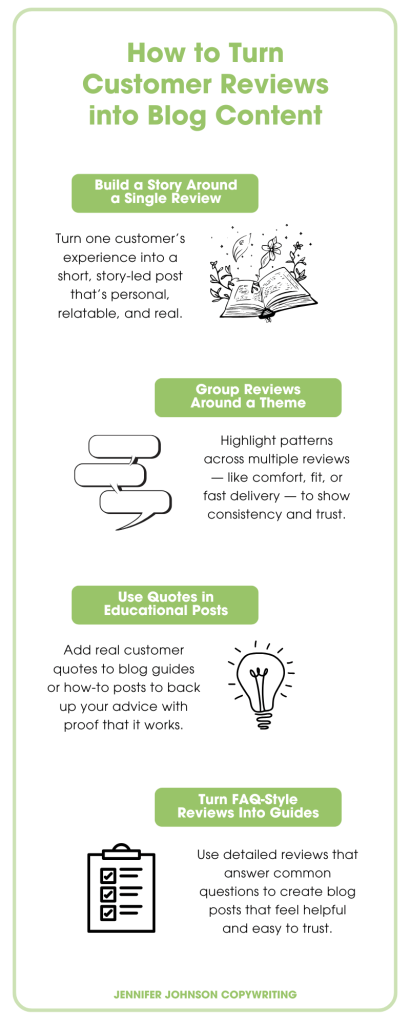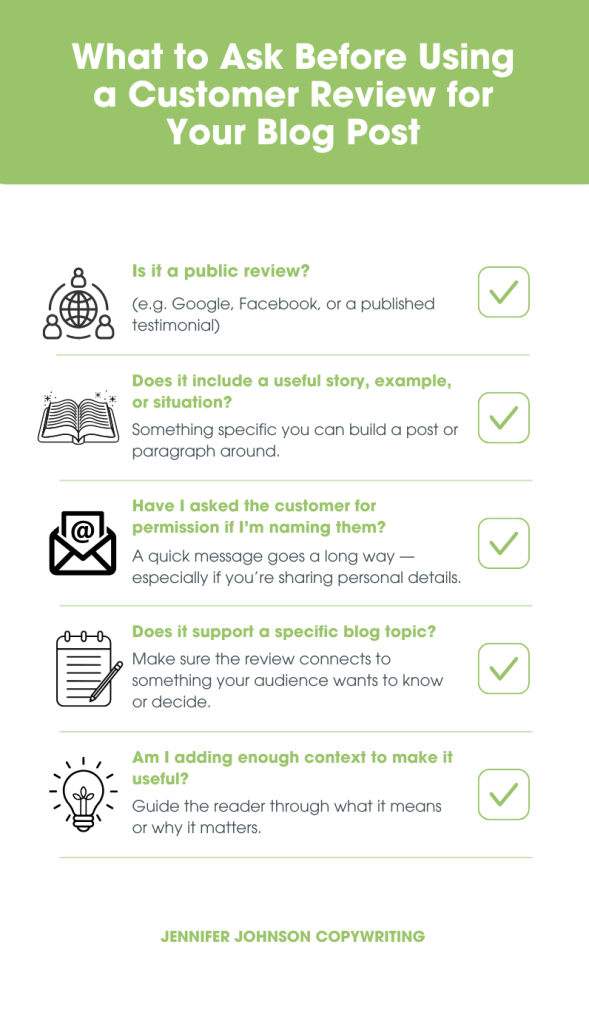How to Turn Customer Reviews into Blog Content For Your Business
- Jennifer Johnson

- May 27
- 7 min read
What would you do if you realised you were sitting on a goldmine of content?
Well, if you’ve got a reviews page (i.e. Google Reviews, Trustpilot, Yelp) then you absolutely are! Those glowing customer testimonials, lovely little messages, heartfelt thank-yous after a great experience — these are all brilliant material you can use for your business blog content.
They’re written in the kind of language your future customers actually use. They’re specific, honest, and often full of the real-world details people look for when they’re deciding what to buy.
Best of all, you’re not starting from scratch! You already have the raw material, now you’re just giving it a new job.
Why Reviews are Worth Building Into Your Content Strategy
If you’ve already got great reviews, you’ve already done the hard part. Someone bought from you, used your product, and liked it enough to tell you.
That feedback doesn’t need to stay tucked away on a testimonials page or occasionally get sprinkled onto your social media.
When you turn reviews into blog content, you:
Show proof in a more natural way: Instead of saying “Our boots are waterproof and comfy,” you’re showing someone else saying it, which is always more believable.
Help future customers feel more confident: People want to know what something’s like in real life. Customer quotes and stories bring that to life better than product specs ever could.
Make your content feel more grounded: Real words. Real experiences. It’s less about marketing, more about showing how your product or service fits into someone’s everyday life.
Find blog ideas without starting from scratch: When you don’t know what to write, reviews are a brilliant starting point. They already highlight what matters to your customers and give you a reason to write about it.
Keep your content feeling personal: Customer voices add warmth, variety, and a human feel to your blog, especially if the rest of your content is quite practical or product-focused.

1. Build a Story Around a Single Review
Some customer reviews tell more than just what they bought; they tell a whole story.
A search. A decision. A result. Maybe even a photo or two.
These kinds of reviews are ideal for turning into blog content, especially when they reflect the kinds of real-life situations your other customers might be in. So instead of just quoting the review, you can shape it into a short, story-led blog post.

You might:
Introduce the customer (first name only is fine) and what they were looking for
Share a few key parts of their review
Add helpful context — what product they chose, why it’s popular, how it works
Link to relevant products or categories
Include tips or links that support other customers in a similar position
Before you publish:
Check with the customer first. Send them a quick message to say, “We’d love to turn your review into a short blog post, would you be happy for us to include your first name and experience?”
Most people say yes (and are flattered!), but it’s always good to ask and get permission.
Example:
A review says: “Was struggling to find wide-fit boots that would be good for our trip to Milford Sound. These arrived quickly and survived a very soggy hiking weekend — couldn’t be happier.”
You could turn that into:
“The Hiking Boots That Got Rachel Through a Wet Weekend in Milford Sound”
→ Walk through why she chose them, what makes them a good option for wide feet, and link to care tips or similar styles.
This kind of blog post feels personal and relatable, and it’s one of the easiest ways to turn real feedback into something useful for future customers. Plus, you've shown Rachel your appreciation and will hopefully turn her into a repeat customer!
2. Group Reviews Around a Theme
If you’ve got lots of reviews that mention similar things, such as comfort, delivery time, durability, or sun protection, you’ve got the makings of a themed blog post.
As instead of focusing on one customer, you’re showing an established, real-life pattern. What are people consistently saying about your product or service? What stands out?

You might group reviews by:
Product features (e.g. warmth, water resistance, ease of use)
Situations (e.g. tramping, beach holidays, busy mornings with kids)
Types of customer (e.g. tradies, parents, older customers, first-timers)
The problem it solved (“Finally found something that fits right” / “Didn’t burn at all this summer”)
Then you can write a blog post around that pattern; pulling in short quotes to support what you’re saying and linking to helpful products or collections.
Example:
“What Our Customers Are Saying About Our SPF Gel — And Why They Keep Reordering!”
→ You share 3–4 short quotes that all mention how easy it is to apply, how light it feels, or how well it sits under makeup. → Then you offer a few notes of your own — what makes the product so popular, how to use it properly, and finish with a link to buy it.
This kind of blog post feels helpful, trustworthy, and easy to write. Plus, it shows your future customers that lots of people are loving the same thing, which can be a powerful nudge to get them over the line.
3. Use Quotes as Supporting Proof in Educational Blog Posts
If you’re already writing blog posts that explain or guide, like “How to Choose the Right Hiking Boots” or “5 Tips for Wearing SPF Daily”, customer quotes can add real weight.
Instead of telling people what works, you’re backing it up with real feedback.
Short quotes can show that it’s not just you saying something; it’s people who’ve used the product and taken the time to say, “Yes, this really did what it said it would do.”

How to do it:
Start with your educational post or guide
Look through your reviews for comments that support what you’re saying
Weave in 1–2 short quotes where they feel relevant
Keep it feeling natural — like a helpful aside, not a bold claim
Example:
In a blog post titled “Choosing the Right Work Pants for Winter in NZ”, you might add in a pull-quote such as the following:
“These kept me warm through a full day on site — and I didn’t overheat once.” – James, Christchurch
That one line adds real-life validation, and speaks in the kind of language other customers will relate to.
You don’t need to build the whole post around the quote. But used sparingly and well, these snippets can give your content more weight and credibility, especially if your audience is still on the fence.
4. Turn FAQ-Style Reviews Into Helpful Guides
Every now and then, a customer will leave a review that’s basically a mini blog post in disguise. They’ll explain how they used your product, what they paired it with, how it held up in certain conditions, or what surprised them most.
These are brilliant for creating guide-style blog posts; especially when they mirror the kinds of questions you get asked all the time.
Instead of answering an FAQ in your voice, you’re showing how someone else solved the problem in real life.

How to do it:
Find a review where someone explains how they used the product
Use their experience as the structure for your blog post
Add in your own notes or advice to support their story
Include links to the product and anything else they used or mentioned
Keep it focused on being helpful — not just glowing
Example:
A customer review says: “Took this sunscreen on our campervan trip up north. Used it every morning and didn’t get burnt once, even out on the water.”
You could turn that into:
“How to Keep Your Skin Protected on a Summer Road Trip (Tips from a Real Customer)”
→ Talk through the product, what makes it easy to travel with, how often to reapply, and link to similar summer essentials.
This style of post is especially useful for:
Seasonal content
Travel, lifestyle, or outdoor products
Businesses that get a lot of “Will this work for…?” questions
And again, always check with the customer before using their name or experience in this way. A quick email or phone call usually does the trick.
Blog Writing Tips for Making It Feel Natural
When you use customer reviews in blog content, the goal isn’t to copy and paste every glowing sentence. It’s to pull out what’s useful, and shape it into something that helps future customers make decisions.
Here are a few tips to keep it feeling easy and genuine:
Don’t just quote, add context. A quote is a great starting point, but your voice matters too. Set the scene, explain what the customer was using or choosing, and link to helpful info.
Use reviews to support the story, not carry it. Let the customer’s words add flavour and proof, but don’t rely on them to do all the heavy lifting. You’re still guiding the reader through the post.
Focus on what’s useful for your audience. Even if a review says lovely things, ask yourself: What does this tell future customers? Make sure you’re pulling out the parts that help someone else make a decision, feel more confident, or learn something.
Keep it consistent with your tone. It’s fine to include quotes that feel a bit different — that’s part of the charm. But you’re still the one shaping the post. Make sure it flows naturally with the rest of your content.
Always ask first if you’re building a post around a customer’s story. A quick “Would you be happy for us to include your review in a blog post?” goes a long way, and most people will say yes if they loved the product.

Wrapping Up
Customer reviews are little windows into what people care about, what helped them decide, and what stood out after the fact. Used thoughtfully, they can turn into blog content that feels personal, grounded, and full of the kind of detail that builds trust for your business over time.
So if you’re sitting on a pile of great reviews and wondering what to do with them, consider this your starting point.
And if you’d like some help shaping them into blog content that feels useful, honest, and good to read, I’d love to chat.






Comments